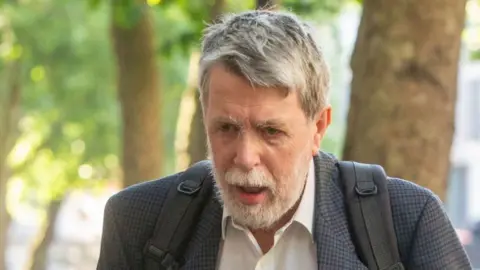 BBC
BBCThe computer expert who helped build the faulty Horizon software has finally spoken under oath about his involvement in the Post Office scandal.
Gareth Jenkins is a key figure, having appeared as an expert witness to defend Horizon in court cases, and is now at the centre of an alleged cover-up. His appearance at the inquiry was long-awaited after being postponed twice.
He gave evidence over four days – the longest run of questions any witness has faced – and gave his version of events.
Here are five key moments from his evidence.
1. He thought Horizon bugs were fixed quickly
Gareth Jenkins referred to Horizon’s overall reliability throughout his testimony, even challenging findings from the landmark Bates v Post Office case that identified issues with the IT system. He acknowledged “individual problems” affecting specific branches but asserted that, as a whole, the system was “working well”.
When questioned about bugs, Mr Jenkins admitted lacking personal knowledge of all known issues, stating he typically became involved when drafted in for problem resolution.
When pressed on how he could provide court evidence without full oversight of existing problems, Mr Jenkins said: “Bugs impacting accounts were rare. Monitoring was in place, and fixes were prompt. Therefore, live system problems were rare, making me confident in its operation.”
He claimed nobody from the Post Office alerted him to unknown issues, and he didn’t actively seek information about bugs he wasn’t involved in fixing. Mr Jenkins admitted not realising the need for comprehensive knowledge when giving evidence and “with hindsight would have done things differently”.
2. He was sent expert witness rules
Mr Jenkins was an “expert witness” in several prosecutions brought by the Post Office. His duty was to the courts, not the Post Office or his employer Fujitsu. His role meant disclosing any relevant information about the Horizon software – even evidence that could help sub-postmasters’ cases.
Lawyers should have ensured that Mr Jenkins understood this. When asked about this by Mr Beer, Mr Jenkins stated that he didn’t know about his responsibilities until the end of 2020.
But Mr Beer showed him a letter from November 2005, written by lawyers working for the Post Office. The letter mentioned that he was an expert witness and, according to Mr Beer, listed his duties in an “easy-to-understand way”. After initially denying he had received it, Mr Jenkins later accepted that it was sent to him.
He said he had “no recollection of having been briefed” on his duties and had “clearly forgotten” about having seen the letter.
3. He knew remote access was possible
The former “distinguished engineer” faced intense questioning regarding remote access – the ability of Fujitsu staff to modify sub-postmaster branch accounts without their knowledge.
In his 2010 witness statement for Seema Misra’s trial, he stated: “No external systems can manipulate branch accounts without user awareness and authorisation.”
During the inquiry, Mr Jenkins accepted knowing that remote access was possible but believed it happened infrequently and left a visible trail. He based this view on “informal chats” with other Fujitsu IT staff.
The former engineer told the inquiry that he only discovered the extent of unrestricted access Fujitsu technical staff had to sub-postmaster accounts during the 2018 High Court battle.
4. He was a ‘willing actor’ for the Post Office
In 2005, Mr Jenkins was asked to provide a draft witness statement in the case of sub-postmaster Noel Thomas. The Post Office wanted his thoughts on how the losses could have occurred.
One possibility, he said, was some sort of system failure. But the Post Office demanded changes, saying the line was potentially “very damaging”. It got deleted.
The inquiry heard he was a “willing actor” in this process. He said he was happy with the changes he ended up with as it still accurately reflected what had happened but used “less emotive words”.
The Post Office was applying the pressure, but he never checked with his own Fujitsu lawyers about signing off evidence that had been toned down. Earlier he was asked to explain attempts to “tweak” his statements, but Mr Jenkins believed this was more of a “tidying up” to make them easier to read. He said he pushed back when the changes went too far.
5. He was ‘better with systems than people’
Four days of forensic questioning meant plenty of room for big revelations. It also meant Gareth Jenkins had nowhere to hide. It was very revealing about the character of the man who has been mentioned so many times at this inquiry.
An IT specialist who spent his entire career at one company, by his own admission, he dealt “better with systems than people”. He would have been happiest engineering and designing, but found himself entangled in something very different. Something, he argues, he didn’t fully understand.
“Can’t you use the report I have already sent you?” Mr Jenkins wrote to a Post Office lawyer in 2012. It is clear he was viewing the growing number of legal queries as a confusing frustration, taking him away from the tech front line.
It is an annoyance that hasn’t gone away.
At one point, Mr Jenkins told the inquiry chair he wanted this “over with”. Given the ongoing investigations, that seems unlikely.
Reporting by Lorna Acquah, Nalini Sivathasan, Emma Simpson and Peter Ruddick

